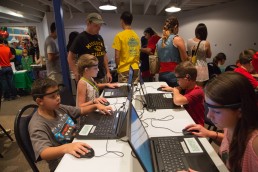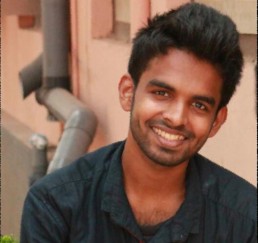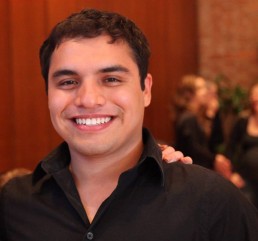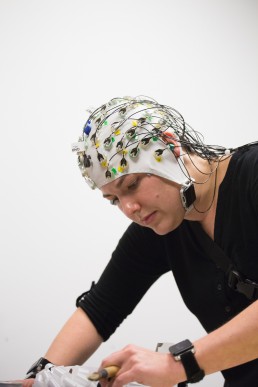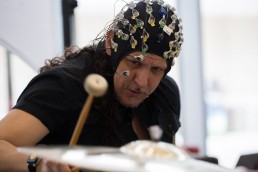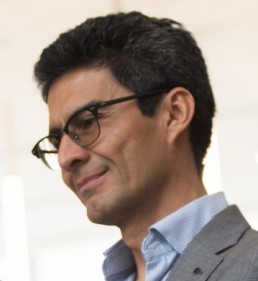Minecraft project
The Project is aimed at investigating the brain dynamics of children playing Minecraft – a creative game that enable players to build 3D constructions using textured cubes in a virtual world; to investigate the feasibility of assaying the neural responses associated with creative game playing in a museum setting and to identify differences in brain activity as a function of age, gender, and gaming experience and identify optimal artifact removal algorithms to clean the available data. Scalp electroencephalography (EEG) and head motion were acquired using off-the-shelf, low-cost, mobile brain-body imaging (MoBI) technology that limited recording to electrodes in the anterior and the temporal scalp areas.
Demographics Information
232 children (166 males/ 66 females) aged 6 to 16 years-old. Information about age, gender, race and level of expertise in playing Minecraft was collected from children and is saved in a separate excel file.

Hardware
Muse Headset
Available Data
-3 axis accelerometer sampled at 50 Hz
-4 channel EEG data (namely, TP9, AF7, AF8, and TP10) sampled at 220 Hz
-meta data including quality bits for each electrode, sampled at 10 Hz
Experimental design
Baseline condition: Looking at a white wall with eyes open. Children were asked to avoid body movements.
Task condition: Play Minecraft for up to 20 minutes while EEG and acceleration data would be recorded. There were no restrictions imposed on the children and they were allowed to play on their will to elicit and capture their natural response.
Data Records
The raw and the metadata from 171 subjects along with the excel sheet containing their demographic information can be obtained by filling out the following form and submitting a request to us. The subject number is referenced to the subject ID.The data associated with each individual subject(named with respect to the subject number) has been saved under a single variable(.mat file). Each individual dataset is further organized in the following way :
1. EEG : matlab structure containing the raw and meta data associated with the 4 channel EEG.
(a) EEG.data : a matlab variable containing the raw EEG data from the 4 channels (in the order TP9,AF7,AF8,TP10).
(b) EEG.timestamp : a matlab variable containing the timestamp associated with the EEG data.EEG was sampled at 220 Hz.
For the first 88 subjects, the baseline and task periods were identified from the accelerometer data and they have 4 additional entries corresponding to baseline and task, start and end sample points.
(c) EEG.baseline_start : a matlab variable containing the sample number associated with the start of baseline condition.
(d) EEG.baseline_end : a matlab variable containing the sample number associated with the end of baseline condition.
(e) EEG.task_start : a matlab variable containing the sample number associated with the start of task condition.
(f) EEG.task_end : a matlab variable containing the sample number associated with the end of task condition.
2. ACC : matlab structure containing the raw and meta data associated with the 3 axis head acceleration.
(a) ACC.data : a matlab variable containing 3 axis accelerometer data
(b) ACC.timestamp : a matlab variable containing the timestamp associated with the accelerometer data. Accelerometer data was sampled at 50 Hz.
3. Metadata : matlab structure containing the signal quality and demographics information associated with each subjects.
(a) Metadata.is_good : a matlab variable containing the boolean meta data provided by Muse which is a strict data quality indicator for each individual channels; 0 = bad , 1 = good. The first column corresponds to the timestamp while the next four corresponds to each channels (TP9,AF7,AF8,TP10). It was sampled at 10 Hz.
(b) Metadata.horseshoe : a matlab variable containing the meta data provided by Muse which is a data quality indicator for each individual channels; 1 = good, 2 = ok,>= 3 bad. The first column corresponds to the timestamp while the next four corresponds to each channels (TP9,AF7,AF8,TP10). It was sampled at 10 Hz.
(c) Metadata.Info : a matlab cell array containing the demographic and electrode contact information associated with that subject. The column corresponds to subject ID, age, gender, race, ethnicity, grade, class, frequency of playing Minecraft and percentage of time of good contact respectively.
Acknowledgment
We also acknowledge the logistical support of all members of the Noninvasive Brain-Machine Interface Systems Laboratory who assisted with the data collection at the Children’s Museum of Houston. This work could not have been done without the support of Julia Banda, Gretchen Schmaltz, and Neelam Damani, Director of Gallery Education at the Children’s Museum of Houston.We also acknowledge the support of graduate, REU, SURF and Methodist Academy students.
Please fill in the following form and submit a request to obtain the dataset.
The dancer. The neuroscientist. The skull cap : What goes on in a dancer's brain?
Contreras-Vidal is now also engaged in the emerging discipline of neuroaesthetics, which combines neuroscience with the study of art, creative movement and perception......
...At the end of the day, it's about a powerful system to understand peoples' actions.
Researchers Observe Effects of Art on the Brain
When it comes to art, beauty may be in the eye of the beholder, but some scientists now are looking for it in bursts of brain waves.
At the intersection of neuroscience and art
"Maybe in 10 years or so, we will have neural technology just like our smart phones; you can wear it and contribute to science," Contreras Vidal says. "You can provide data that can be mined, whether you're an engineer, or a doctor, or an artist trying to create something new.
Andrew
Andrew’s PhD research involves developing systems that use scalp electroencephalography (EEG) to control robotic hand prostheses for restoring motor control to amputees. His research interests include enhancing user friendliness and neural feedback in brain imaging devices. His contributions to the Brain on Art projects in the University of Houston include developing user interfaces of brain imaging devices for public outreach, programming interfaces that allow users to control the environment through neural signals, and surveying mobile brain imaging devices currently on the market.
Akshay
I am a Ph.D. graduate student at the University of Houston. My research involves classification and decoding of non-invasive Electroencephalographic (EEG) signal using
and deep learning techniques. I am in search of understanding the engineering and spiritual meaning of human existence. I aspire to setup a research environment aiming at bringing innovation in the fields of healthcare, education and spirituality through technology, taking inspiration from nature’s design.
Jesus
Exquisite Corpse - Visual Artists
Artists wore skullcaps fitted with EEG electrodes and inertial sensors as they played Exquisite Corpse - the collaborative, chance-based game made famous by the Surrealists in the 1920’s. The
performance-study seeks to uncover clues to what happens in the brain as people create and contemplate art. Working simultaneously before a live audience, each artist has 15 minutes to begin creating an artwork. After 15 minutes, their work-in-progress is concealed with a cloth, leaving only a small portion exposed. The artists then rotate stations and take turns adding to each other’s creations for two additional 15-minute increments. Their brain activity is projected onto a nearby screen as audience members watch and also contribute their MoBI data.
[soliloquy id="429"]
[huge_it_videogallery id="1"]
Exquisite Corpse - Musicians
Wearing skullcaps equipped with sensors, different musicians play a variation of Exquisite Corpse, a collaborative, chance-based game made famous by the Surrealists in the 1920s — in which they play saxophones and drums instead of drawing. It is a collaboration between Houston Community College (HCC), Houston-based artists, Blaffer Art Museum, and the University of Houston’s Noninvasive Brain-Machine Interface Systems Laboratory, seeking clues to what happens in the brain as people create, perform, and contemplate art in a variety of disciplines.
The study is funded by the National Science Foundation (#BCS 1533691) and led by engineering professor Jose Luis Contreras-Vidal — to study connections between the brain and creativity, expression, and the perception of art.
[soliloquy id="411"]
Dr. Contreras-Vidal
Jose Luis Contreras-Vidal is a Hugh Roy and Lillie Cranz Cullen Distinguished Professor of Electrical and Computer Engineering at the University of Houston. Dr. Contreras-Vidal’s research focuses on neural, cognitive and rehabilitation engineering, and development of noninvasive brain-machine interface (BMI) and other human-machine systems to restore or assist movement in clinical populations with upper and lower-limb disabilities. His laboratory has pioneered the development of noninvasive neural decoding methods based on scalp EEG and closed-loop BMIs to robotic exoskeletons and prosthetic limbs to restore motor function in individuals with spinal cord injury, stroke, and limb amputation. He has also developed experimental and computational approaches to acquire brain activity in ‘action and in context’ in complex real settings.


